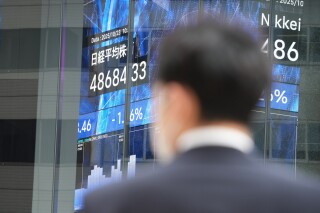Asian shares experienced a positive shift on Friday, following confirmation from the White House that President Donald Trump is set to meet with Chinese President Xi Jinping next week. This announcement has alleviated some uncertainty surrounding the ongoing trade tensions between the United States and China, although the potential for a substantial trade agreement remains ambiguous.
Chinese markets reflected this optimism, with the Hong Kong Hang Seng index rising by 0.6% to close at 26,122.10. The Shanghai Composite index also gained, increasing by 0.4% to 3,938.98. Japan’s Nikkei 225 rebounded significantly, growing nearly 1.5% to 49,380.25. The tech sector particularly benefited from the improved sentiment, spurred by the anticipated meeting between Trump and Xi.
In Japan, new data indicated that the core inflation rate rose to 2.9% in September, up from 2.7% in August. Despite these inflationary pressures, the Bank of Japan is expected to maintain its current interest rate levels during its upcoming meeting next week, as newly elected Prime Minister Sanae Takaichi has expressed a preference for low rates.
Meanwhile, South Korea’s Kospi index surged by 2.3% to a record high of 3,935.75, buoyed by gains on Wall Street and the news of the Trump-Xi summit, which has eased concerns regarding trade. In contrast, Australia’s S&P/ASX 200 index dipped slightly, falling less than 0.1% to 9,027.00, following preliminary data that indicated a contraction in Australia’s factory activity to 49.7 in October, down from 51.4 in September.
India’s BSE Sensex remained largely unchanged, while Taiwan’s stock market was closed for a holiday.
The positive momentum in Asian markets comes on the heels of a rally on Wall Street, where stocks approached record highs on Thursday. The S&P 500 increased by 0.6% to 6,738.44, just 0.2% away from its all-time high set earlier this month. The Dow Jones Industrial Average rose by 0.3% to 46,734.61, while the Nasdaq composite climbed 0.9% to close at 22,941.80.
Oil prices also reacted to these developments, initially rising after Trump’s announcement of “massive” new sanctions on Russia’s oil industry, targeting companies like Rosneft and Lukoil. These sanctions are intended to pressure Vladimir Putin to end the ongoing war in Ukraine. Although oil prices saw a recovery of approximately 5.5% following the sanctions, they ultimately slipped on Friday. The U.S. benchmark crude price fell by 22 cents to $61.57 per barrel, while Brent crude decreased by 21 cents to $65.78.
Corporate earnings reports from major U.S. companies also played a role in driving stock prices higher. Dow Inc. saw a significant jump of 12.9%, while Las Vegas Sands surged by 12.4% after both companies reported stronger-than-expected earnings. Electric vehicle manufacturer Tesla rebounded from an early loss, increasing by 2.3% despite reporting lower profits but higher-than-expected revenue.
As companies strive to maintain solid profit growth, this pressure contrasts with concerns that stock valuations have risen excessively following a remarkable 35% increase in the S&P 500 since April.
In other markets on Friday, the price of gold decreased by 0.4% to $4,129.30 an ounce, following a previous climb of 2% to $4,145.60 per ounce. The U.S. dollar strengthened against the Japanese yen, rising to 152.96 from 152.60, while the euro fell to $1.1608 from $1.1618.
This combination of factors illustrates the intertwined nature of international markets and the potential impacts of geopolitical developments on global economies.







